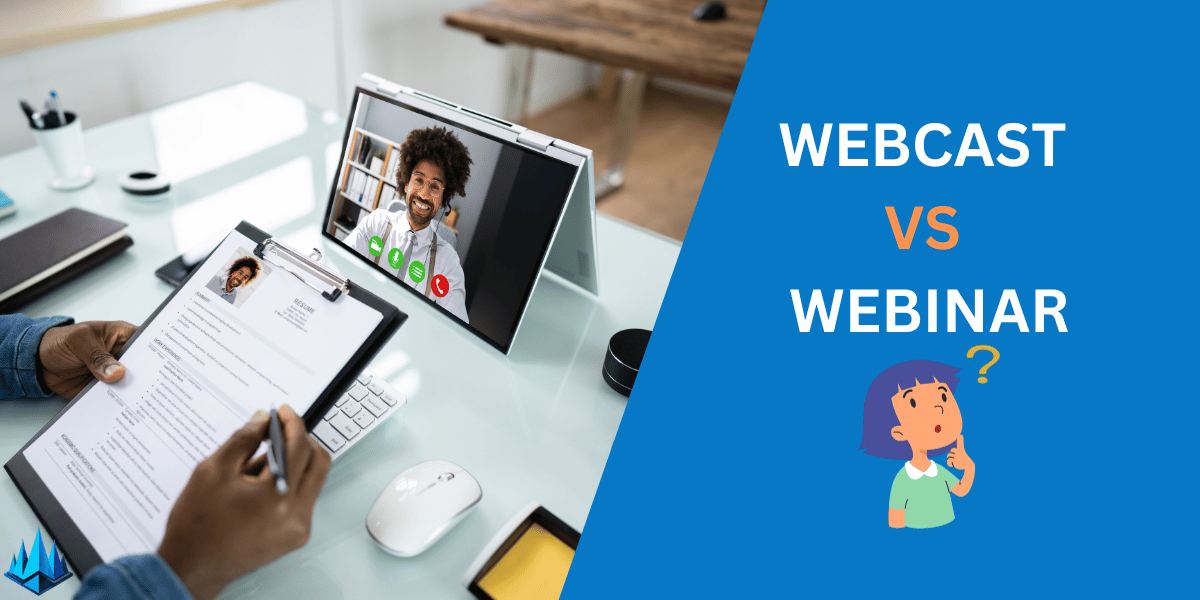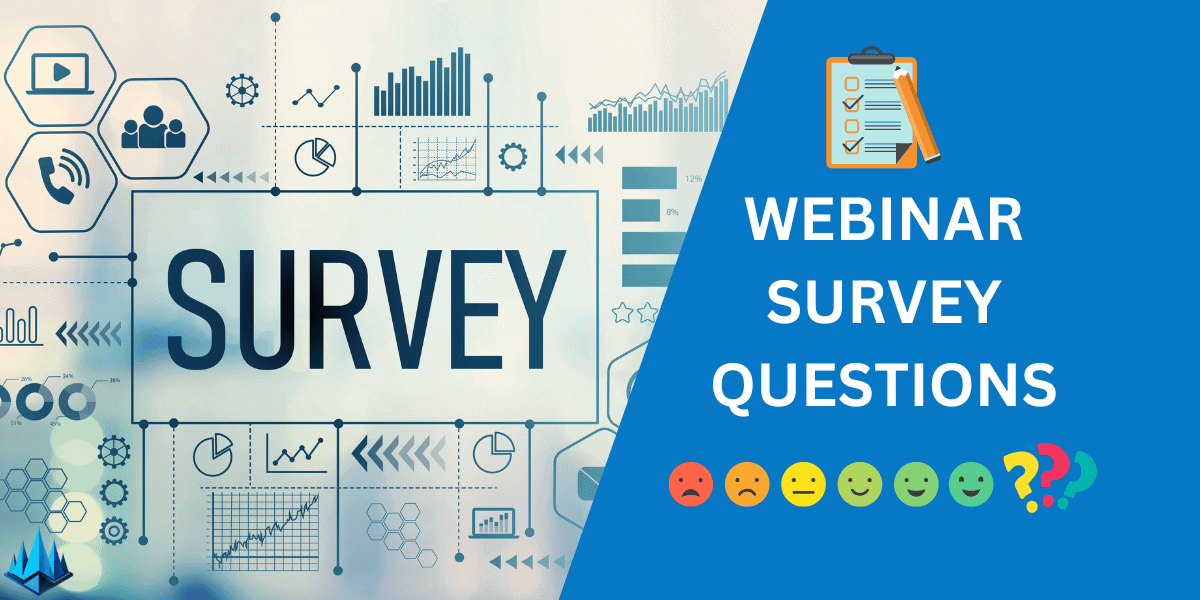The “webcast vs webinar” question often pops up in the ever-evolving digital communication landscape. But what sets them apart? As we navigate through 2024, understanding the distinction between a webcast and a webinar is crucial for anyone looking to maximize their online presence and engagement.
With many online tools at our fingertips, choosing between a webcast and a webinar can be overwhelming. This confusion can lead to ineffective communication strategies, resulting in lower audience engagement and missed opportunities.
Imagine hosting an event that doesn’t hit the mark with your audience. The reason? There is a mismatch between your content delivery method and your audience’s expectations. The difference between a webcast and a webinar, although subtle, can significantly impact the effectiveness of your digital communication.
Fear not! This article is designed to demystify these two formats. Understanding the key characteristics and best use cases allows you to make informed decisions that resonate with your audience. Whether you’re a seasoned digital communicator or new to the online event scene, grasping these differences is vital in this digital age.
Key Takeaways
- Understand the core differences between webcasts and webinars.
- Learn which format best suits your communication needs.
- Discover how choosing the right format can enhance audience engagement.
- Gain insights into effectively leveraging these tools in 2024.
Webcast or Webinar: Which Suits You Best?
1. Audience Interaction: How Webinars Win
Webinars offer a higher level of audience interaction compared to webcasts. In a free webinar, participants can ask questions, participate in polls, and engage in real-time discussions. This interactive element makes webinars ideal for educational sessions or workshops where audience participation is critical. I’ve found that webinars create a more dynamic and engaging learning environment, fostering a sense of community among participants.
2. Reach and Accessibility: The Webcast Advantage
Webcasts are designed to reach a broader audience. They are often broadcast live and can be accessed by many viewers simultaneously. This makes webcasts perfect for large-scale events like product launches or company-wide announcements. In my experience, webcasts have been instrumental in reaching a global audience and overcoming geographical and time zone barriers.
3. Technical Requirements: Simplifying with Webcasts
Webcasts typically require less technical setup and expertise compared to webinars. You can broadcast your message to a large audience with a simple streaming setup. This simplicity has been a boon for many clients who prefer an easy-to-use platform for quick and wide dissemination of information.
4. Duration and Pace: Tailoring with Webinars
Webinars often have a more structured and paced format. They are usually shorter than webcasts and include specific time slots for presentations, Q&A sessions, and discussions. This format allows for a more detailed exploration of topics, as seen in numerous educational webinars I’ve attended.
5. Cost-Effectiveness: Evaluating Webcasts
Generally, webcasts can be more cost-effective, especially for large-scale events. They require fewer resources in terms of moderation and interaction tools. This cost-benefit is particularly noticeable when broadcasting to thousands of viewers, as seen in several corporate announcements.
6. Content Type: Diverse with Webinars
Webinars allow various content types, including interactive workshops, training sessions, and panel discussions. This versatility makes them suitable for diverse topics and formats, something I’ve leveraged in various professional development sessions.

7. Engagement Tools: Interactive Edge of Webinars
Webinars provide engagement tools like chat boxes, Q&A sessions, and breakout rooms. These tools enhance participant engagement, as I’ve experienced in several interactive webinars.
8. Recording and Playback: Accessibility of Webcasts
Webcasts are often recorded and made available for on-demand viewing. This feature extends the life of the content, allowing people to view it at their convenience. I find this feature incredibly useful as someone who frequently refers to past webcasts for information.
9. Event Scale: Going Big with Webcasts
Webcasts are better suited for large-scale events because they can handle vast numbers of viewers without compromising streaming quality. I’ve seen webcasts effectively used for primary product reveals and large-scale educational broadcasts.
10. Personalization: The Unique Touch of Webinars
Webinars offer more opportunities for personalization and audience targeting. They can be tailored to specific groups, allowing for a more focused and relevant experience. This has been a game-changer in several niche webinars I’ve conducted.
11. Monetization Potential: Webinars as Revenue Streams
Webinars can be more easily monetized. With features like registration fees, they can serve as a revenue stream, something I’ve capitalized on in specialized training sessions.
12. Speaker-Audience Ratio: Intimacy of Webinars
Webinars often have a lower speaker-to-audience ratio, fostering a more intimate and interactive setting. This has been beneficial in sessions where detailed feedback and discussion are required.
13. Production Value: Simplifying with Webcasts
While webcasts have high production value, they can be effectively executed with minimal setup. This flexibility has been crucial in several impromptu webcasts I’ve been involved with, where the message was more important than the production.
Overall Winner: Webcast vs Webinar Showdown
When weighing the merits of the webcast vs webinar debate, it’s essential to recognize that each has unique strengths tailored to different needs and contexts.
Webcasts shine in their ability to reach vast audiences, making them ideal for large-scale events or broad messaging.
Their simplicity in setup and potential for broader reach can be a game-changer for events like product launches or corporate announcements.
On the other hand, webinars offer a more intimate and interactive experience, perfect for educational sessions, workshops, or detailed discussions where audience engagement is critical.
The choice ultimately hinges on your specific goals: webcasts are your go-to if you aim for maximum reach and simplicity. For interaction and focused learning, webinars take the crown.
Ultimately, both platforms are winners in their own right, each excelling in scenarios that play to their strengths. The key is to align your choice with your event’s objectives and audience preferences.
Final Thoughts
As we reflect on the webcast vs webinar comparison, it’s evident that both platforms have distinct roles in digital communication.
Choosing between a webcast and a webinar is not about picking a clear winner but understanding which platform best aligns with your specific goals and audience needs.
Webcasts are your ally for quickly and efficiently broadcasting to a larger audience, ideal for one-to-many communications like company-wide announcements or product launches.
Webinars, in contrast, thrive in settings that demand interaction and engagement, such as educational sessions or collaborative workshops.
The decision concerns your event’s purpose: Do you need to reach a broad audience with a straightforward message, or are you looking to engage a smaller group in a more interactive setting?
By carefully considering these aspects, you can harness the full potential of each format, ensuring your message resonates effectively with your intended audience.
Frequently Asked Questions
What is the Main Difference Between a Webcast and a Webinar?
The primary difference lies in their format and purpose. Webcasts are typically one-way broadcasts aimed at large audiences, focusing on information dissemination. Webinars, however, are more interactive and more diminutive in scale, allowing for real-time engagement, Q&A sessions, and discussions, making them ideal for educational and collaborative purposes.
Can Webinars Be Recorded and Viewed Later Like Webcasts?
Yes, webinars can be recorded and available for on-demand viewing, similar to webcasts. This feature allows participants who missed the live session to access the content at their convenience, increasing the longevity and reach of the webinar content.
Are Webcasts More Cost-Effective Than Webinars?
Generally, webcasts can be more cost-effective, primarily targeting a large audience. They require less interaction and engagement tools, which can reduce costs. However, the price can vary based on the production value and platform.
Can Webinars Facilitate Real-Time Interaction Better Than Webcasts?
Webinars are designed for real-time interaction and are better equipped for this purpose than webcasts. They offer features like live Q&A, chat options, and breakout rooms, allowing for a more engaging and participatory experience for the audience.
Is a Webinar or Webcast Better for Educational Purposes?
Webinars are generally more suitable for educational purposes due to their interactive nature. They allow real-time questions, discussions, and collaborative learning, making them ideal for workshops, training sessions, and educational seminars.











